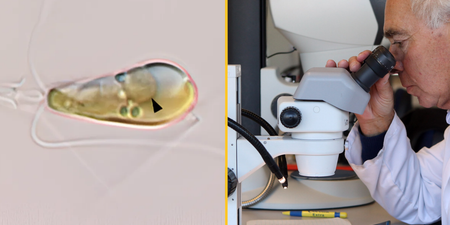Males’ slimy advances can be dangerous for females during an ‘explosive’ breeding season
Males of the species are often known for coming on a bit strong. Even for making unwanted advances.
And it turns out that in the frog kingdom, the females are going to extremes to put their randy mates off.
Turns out they’re not hoping to mate with every interested suitor, and are faking their own deaths to escape their slimy advances.
According to a study published Wednesday in Royal Society Open Science, female European common frogs have been observed engaging in “tonic immobility,” essentially pretending they’re death to avoid mating.
And it seems the drastic measure seems to have evolved in order for females to survive the often intense, and potentially dangerous mating season, Carolin Dittrich, an evolutionary and behavioural ecologist who conducted the research as part of the Natural History Museum Berlin, told ABC News.
According to the study, the European common frogs engage in an “explosive” breeding season, where males fiercely compete for available females which results in scrambling and fights.
Males, the study said, may harass, coerce or intimidate females into mating.
During these outbreaks of violence, female frogs, Dittrich said, can get trapped in “mating balls”. These occur when several males cling to them in the hope of being the lucky one.
According to the ABC report, Dittrich’s research was initially aimed at determining whether male frogs were choosing mates with bigger bodies. Larger females tend to have more eggs, so produce more offspring.
That study showed that wasn’t the case, and rather male frogs weren’t discriminating at all.
Researchers also observed that females were showing avoidance behaviours toward males – a behaviour not expected to occur in the species because “explosive” breeders usually only have a short period to mate, Dittrich said.
One of the behaviours used includes a turning motion, in which female frogs turn and twist their bodies to get out of the grip of the males – a technique used more successfully by smaller females – as well as engaging in a call that is similar in the frequency and structure to the calls males make.
The “most astonishing” behaviour, however, was females using tonic immobility – or feigning death – Dittrich said.
Female European common frogs do not have many opportunities to increase their fitness because they reproduce once a season, which is what likely led to the evolution of the avoidant behaviour, Dittrich said.
Researchers reportedly observed female European common frogs stretching their arms and legs straight from the body, in a way that could appear similar to rigour mortis, Dittrich said.
She added there was little literature to suggest other vertebrate species used the tactic.
Faking death has previously been observed in amphibians, spiders and dragonflies, but the purpose is typically to avoid being detected by a predator, she added.
Read the Royal Society Open Science paper – female mate avoidance in explosively breeding frog – here.
Family find frog in packet of ‘triple washed’ spinach
Researchers want to give grey squirrels contraception to stop overpopulation
Horrifying close-up of ant’s face wins Nikon’s photo competition prize





















































